
The St Regis Grand Hotel Rome offers probably the most outstanding history of any hotel in the eternal city. In 1894, it started as the Grand Hotel, a brainchild of the most mythical name in the hotel business: Cäsar or César Ritz, the son of a humble goat farmer in the Swiss village in Niederwald, a village in the Swiss Alps.
The lobby of the St Regis Grand Hotel Rome offers a dramatic entrance into the world of luxury, which may remind some luxury travelers for instance of The Ritz London (which opened in 1906) or the Ritz Paris (1898) for the simple reason that its architect is the same: Charles Mewès (1860-1914).
At the time, it was considered Italy’s most elegant hotel and the only Italian project of the London based Savoy Group. From the Savoy in London came also its first chef, Auguste Escoffier, the most prestigious name in the culinary field. Ritz and Escoffier had first worked together in the summer seasons of 1875 to 1882 in the Grand Hotel National in Lucerne, Switzerland. They redefined luxury and style. In Rome, he introduced the international standard with a staff equally half-Italian, half-French. In addition, the Grand Hotel’s American Bar became the hottest spot in town.
At the time of the opening of the Grand Hotel, Rome was a booming city, with a population that had tripled over the past 20 years. The Italian elite looked to the example of London and concluded that they needed a leading hotel in their city. In 1891 the Italian Premier and Minister of Foreign Affairs, Marquis di Rudini, approached the Swiss hotelier César Ritz in the lobby of London’s Savoy Hotel. The Premier was accompanying Italy’s young Crown Prince, the Prince of Naples, on a state visit to London, then the world’s capital.
With the transatlantic liners disembarking hundreds of American tourists in London who are bound for the Eternal City, the Premier argued that Rome needed a state-of-the-art hotel too. The Americans stay at The Ritz London and then in Paris, they expect to find a true luxury hotel in Rome too.

The elegant lobby is in reality even more impressive than on this photograph. Photo © St Regis Grand Hotel Rome.
In the late 19th century, the rich traveled by train, for instance with the sleeper of the Calais-Nice-Rome Express, operated by the Belgian Compagnie Internationale des Wagons Lits. Therefore, to build a hotel near the train station was just common sense. The hotel was far from the Colosseum, the Vatican and other tourist sights, but in addition to the railway station close to the government quarters of the Quirinale and opposite the Roman Museum, which had opened its doors in 1889.
From a fellow Swiss, Franz Josef Bucher-Durrer, whose family owned the Hotel Buergenstock in Switzerland – where Ritz had once worked – and who run the Hotel Minerva in Rome, César learned that an impressive and perfectly located building was available. A certain Mr Cavallini had left it unfinished because he had run out of money. While building the foundation walls, they had unearthed the western wall of Emperor Diocletian’s baths. The alerted archeological society stopped the project the examine what was underneath. Cavallini lost time and money.
The site of the Grand Hotel has a long history. It had served as a hospice for the deaf and dumb, a factory producing Indian printed calico cloths and part of the Basilica di Santa Maria degli Angeli, built in the Middle Ages.
Cavallini had removed the old walls and commissioned the architect Giulio Podesti, whose works included the recently finished Policlinico hospital, to build a hotel in a traditional style.
Ritz made Cavallini a generous offer the bankrupt developer could not refuse. Andreas Augustin and his team of hotel historians found out that César Ritz and Callini signed two letters: one signed on behalf of the Savoy Company and one which Cavallini signed for Ritz personally.
The employer of César Ritz in London, the theatre impresario Richard D’Oyly Carte, had no choice but to accept his manager’s plan to buy a hotel in Rome because he was the best man in the hospitality industry, about which D’Oyly Carte himself had little knowledge.
The two parties agreed to a new five-year agreement, which incidentally led to the acquisition of Claridge’s, reborn in its current guise in 1898 as hotel of the London Savoy family. Ritz founded the London and Foreign Hotel Syndicate to run the Roman venture, with César Ritz himself holding (1,867 shares), Auguste Escoffier (101), restaurant assistant Echenard (401), D’Oyly Carte (1,200), the Savoy Company director Michael Gunn (400) and composer Sir Arthur Sullivan (200).
The deal went through and Ritz presented the second, secret letter back to Cavallini, which stated that once the deal done, Ritz would get £2000.-. In short, César Ritz took a bribe. Back in London, he took a bonus for his successful negotiation with Cavallini.
Ritz installed Alphonse Pfyffer as general manager, whose father had been César’s employer during his first post as general manager, at the Grand Hotel National in Lucerne.
Initially, the grand opening was planned for January 17, 1893 the fifth wedding anniversary of César and Marie Ritz. In early December of 1892, Pfyffer alerted his superiors in London that the works had fallen behind schedule not only because of the endemic corruption, but also because Italy was hit hard by the 1890s world recession. The banking system collapsed and Italy even had to temporarily withdraw from the international gold standard. Civil unrest broke out, revolutionary agitation was rampant and bombs were not uncommon.
Ritz sent Pfyffer to the best delicatessen in town and invited the workers to an impromptu banquet on the site of the ballroom. The men got the message, and work continued. On January 10, 1894 the Grand Hotel opened with a bang. More than 1000 guests gathered for a cocktail party in the salons of the lavish hotel.
The opening was no minor affair. Among the guests were the Italian King Umberto I, Emperor Wilhelm II of Germany and Pope Leo XIII, to name just the most illustrious.
The Grand Hotel set new standards. Its water system was the finest in Rome. The plumbers came from London. Running hot water and bathtubs were virtually unknown in Italy at the time. It was Italy’s first hotel to be lit throughout by electricity and the first where every single guestroom had its own private bathroom. It was a synthesis and symbol of tradition, opulence and Belle Epoque modernity.
The hotel was an instant success. After the inauguration gala, King Umberto I and Queen Margaret of Italy hosted a luncheon at the Grand Hotel, which became the place were kings and queens, princes and princesses, dukes and duchesses rested, dined and socialized. Princess Victoria of Sweden spent year after year her spring time at the hotel, following medical advice from her doctor to profit from the mild climate of Rome.
Marie Louise Ritz tells in her memories the story of a lovely flower girl who was permitted to sell her wares occasionally in the Grand Hotel’s public rooms. She impressed with an exquisite singing voice. Young Carlo Rudini, the ex-president’s son, fell head over heels in love with the beauty who became a famous opera star under the name Lina Cavalieri, the most photographed opera singer of her time (get her biography by Paul Fryer and Olga Usova from Amazon.com or Amazon.de).
In December 1895, the London and Foreign Hotel Syndicate sold the Grand Hotel Rome to the shareholders of their own English firm, the Savoy Company, for a cool £260,000. The men behind it, Ritz and co., made a tidy profit.
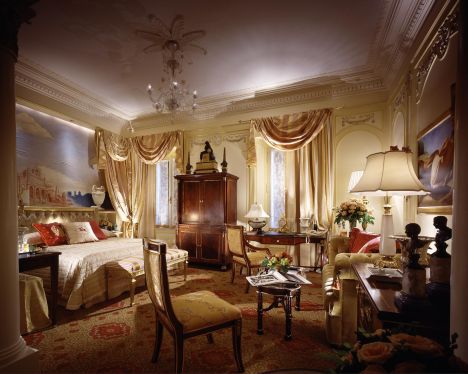
Deluxe Room. Photos © St Regis Grand Hotel Rome.
It was the ambition of César Ritz to create a true winter season in Rome. He succeeded. The apogee of the winter season was Christmas. The Grand Hotel always staged the most lavish and glitziest gatherings.
The social highlight of the decade came in autumn 1896. The heir to the Italian throne, Prince Vittorio Emanuele, married Elena Petrovi-Njegos, Princess of Montenegro. At the time, the Marquis di Rudini had again become prime minister. The beautiful Elena arrived by train at the Termini railway station. Her entourage filled entire floors at the Grand Hotel Rome.
The following year saw the abrupt end of the era Ritz at the Grand Hotel Rome. The trouble for the Swiss hotelier began in London, where the accounts of the Savoy revealed a staggering drop in net profits over a two year profit. Abroad, the results were not better. Ritz advanced less business, increased taxation and new installations as the reasons for the problems in Rome. The London and Foreign Hotel Syndicate hired a private detective and ordered an audit. Ritz had began to devote to much time to outside projects ranging from selling patents for mil sterilization to the Bernese Alpine Milk Company to taking over the Frankfurter Hof hotel. He had also set up his own syndicate in 1897, the Ritz Hotels Development Company, and became its director in 1897. He was offered fantastic sums in the United States to teach inn-keeping de luxe to the New World. Even Lorenz Adlon in Berlin asked for his advice. His partners at the London syndicate were fuming, not only at Ritz’s separate dealings, but also because they discovered the secret commission he had taken in context with the purchase of the Grand Hotel Rome.
The situation was not better for Auguste Escoffier. The investigation discovered that the chef was engaged in shady dealings on the side, e.g. supplying goods to the hotel trough his own companies at inflated prices without revealing his involvement. On March 7, 1898 the directors of the company fired Ritz, Escoffier and Echenard, Ritz’s right-hand man at the Savoy. The official reasons were specified as “gross negligence, breaches of duty, and mismanagement”.
As one of the most famous chefs in history, Escoffier easily found a new job at the Carlton Hotel in London, where his reputation would reach iconic status. César Ritz had already moved to Paris where his opened his Ritz Hotel at Place Vendôme. His success story continued later in London, Budapest and other cities. His name also lives on in the Ritz-Carlton corporation which spread through Europe and North America. In 1902, Ritz suffered a nervous breakdown. He had to be kept away from clients of his Paris hotel when he began screaming at guests and hurling ashtrays at innocent bystanders. In 1912, he entered a psychiatric hospital in Lausanne before being transferred to a clinic near Lucerne where he died in 1918.
Alphonse Pfyffer had not been involved in the irregularities and had become the head of the Grand Hotel Rome which, in 1899, was incorporated into the new Savoy Limited Company.
The 1900 season was extraordinary. Among its highlights were the arrival of the King and Queen of Italy on March 29, together with mystery guest George William, Duke of Cambridge, the grandson of King George III and cousin of Queen Victoria. On April 12, the Duke of Cambridge was still residing in the hotel, Count Leo Tolstoy, the author ofWar and Peace, arrived at the Grand. He had become a champion of social reform and probably discussed his ideas with the two Romanov grand dukes who were dining with him.
At the beginning of the new century, in the liberal ear of prime minister Giovanni Giolitti, business and tourism were flourishing. In 1910, the Grand Hotel was running a one page ad in the New York Times. In the spring of 1913, the hotel even had to turn guests away. The First World War changed everything.
The St Regis Grand Hotel Rome is not only a historic landmark, even history was made in the hotel. Andreas Augustin offers several anecdotes in this regard.
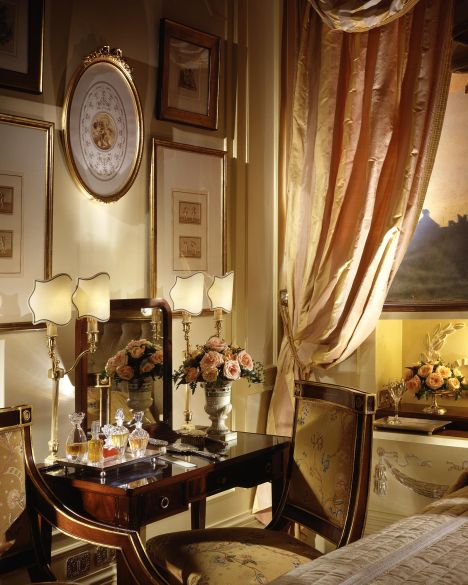
Deluxe Room detail. Photos © St Regis Grand Hotel Rome.
In 1914 the German statesman and former chancellor Prince Bernhard von Bülow stayed at the Grand Hotel while unsuccessfully negotiating Italy’s entry into the war. In 1915, Italy indeed enter the war, but on the side of the Entente powers Britain, France and Russia. The First World War was a terrible blow to the tourism industry. Guests stayed at home.
In 1922 Benito Mussolini’s famous March on Rome was not a march. The Fascist dictator – together with many of his followers, arrived from Milan to Rome by first-class train. At first, il Duce stayed at a second-string hotel, but soon moved to the Grand Hotel where he took a suite on the second floor where he stayed for the winter.
The staunchly anti-Fascist writer and journalist of Greek-Neapolitan origin Matilde Serao stayed also in the hotel. When Mussolini bumped into her in a salon, he said: “Signora Serao, I am told that you are an incurable anti-Mussolinian. Would you allow me to greet you anyway.” The writer answered with a smile: “You are mistaken. I am not against Mussolini. I am against Fascism and all those who believe in it.”
In 1913, Mussolini had begun a 23-year liaison with the Jewish publicist Margherita Sarfatti from Milan. When she was in Rome, she stayed at the Continental, just down the road near Termini station. One night, Mussolini sneaked out of the hotel to secretly meet her. A chauffeur spotted him and alerted the police. Several undercover agents followed him. When Mussolini came back to the hotel, he found the head of the Italian police, Emilio De Bono, sitting in his suite. Like a naughty schoolboy, he had to promise never to do it again. Of course, time and again the dictator broke with the protocol and made a habit of these nocturnal escapades.
On December 15, 1922 Benito Mussolini summoned his most trusted collaborators to the hotel for the first ever meeting of what would be named the Fascist Grand Council. They discussed plans to consolidate the Duce’s dictatorial power. They met again at the Grand Hotel on January 12 and February 12, 1923.
In the 1930s, the Italian royal family held their plain-clothes court at the Grand Hotel, sending the bill to the Quirinale. Some ladies in waiting even lived at the hotel in order to be close to Queen Helena.
In 1931, another royal guest arrived at the hotel, the Spanish King Alfonso XIII who had been forced into exile by the win of the Republican parties in the general election the year before. He would live out the rest of his days in the Grand Hotel Rome where he died on February 28, 1941.
In 1935, Beatriz of Bourbon and Battenberg, the aunt of the present day King Juan Carlos of Spain, married Prince Alessandro di Torlonia at the Jesuit Chiesa del Gesù. Afterwards, some 125 wedding guests attended the reception held at the Grand Hotel. It was the day Don Juan, heir to the Spanish monarchy, met his future wife, his cousin Princess Maria Mercedes of Bourbon-Two Sicilies. They married in Rome later that year.
In the mid-1930s, the worst of the economic crises was over. The CIGA hotel group bought the Sindacato Italiano Sviluppo Alberghi, bringing in the process the Grand Hotel and the Excelsior on Via Veneto of Rome into the CIGA fold.
Mussolini’s new friends came to stay at the Grand Hotel Rome, among them the Nazis von Ribbentrop, Goering and, later, even Hitler himself.
From 1939 to 1945, the CIGA group ended every year with a debit balance. Many of its hotels were forced to shut down.
In 1943, German soldiers marched into Rome and left only in mid-1944. The Allied command set up its headquarters at the Excelsior, the Grand’s sister hotel. On July 4, 1944 four days after the liberation of Rome, in a suite of the Grand Hotel, the leaders of the anti-Fascist resistance movement CLN, including Iavanoe Bonomi and Alcide De Gasperi, met with Prime Minister Badoglio. It was the first non-clandestine meeting of the CLN. The seeds of modern Italy were sown at the Grand Hotel since a new government materialized from the talks. It lasted only until November 1944, but the Bonomi cabinet started the process of the economic and administrative reconstruction of Italy.
In addition to the high aristocracy, writers, film stars and other celebrities flocked to the Grand Hotel Rome. In its early years, the writer Gabriele d’Annunzio and his wife, the duchess Maria Hardouin di Gallese became regular guests. The d’Annunzio family rubbed shoulders with French novelist Emile Zola, who was known for his healthy appetite. While his wife would flirt shamelessly with her Italian tutor, Zola would slip off to the kitchen for a conversation with the chef.
After the Second World War, the cinema made Rome fashionable again. To get there became easy. In 1959, TWA ran its first direct flight from New York to Rome. The following year, Fellini released La Dolce Vita, the tale of the jaded Roman tabloid journalist played by Marcello Mastroianni. The film also introduced the term “paparazzi”, named after Mastroianni’s colleague in the movie, the photographer Paparazzo.
Ava Gardner was a regular guest at the Grand Hotel Rome. Followed by an annoying paparazzo, the furious actress stormed into her suite and instructed her maids to pack immediately. The legendary porter Pino Buso calmed the situation by sending her a magnificent blue orchid together with a touching card. It read: “I have been, I am, I will be a fan of yours.” Ava Gardner was moved by this display of Roman charm, ordered to unpack her suitcases and shared a glass of Dom Perignon with Buso, finally staying anther ten days in the hotel.
Since the Second World War, the hotel has attracted many Hollywood stars from Liz Taylor and Richard Burton to Meg Ryan, George Clooney, Brad Pitt, Richard Gere and Hugh Grant, to name just a few.
In 1963 the hotel got a face-lift, fitting air-conditioning and other necessary updates. It was the beginning of a seven-year modernization program. A new hotel restaurant, “Rallye”, opened in 1965. Executive chef Vittorio Saccone made it a success to the point that tables had to be reserved one month in advance. The restaurant was the pride of the new general manager Dr Natale Rusconi, who wrote a glorious chapter of the hotel’s history and just retired at the of 2007 after a 30-year career at the helm of the iconic Hotel Cipriani in Venice.
At the “Rallye”, one could spot Liz Taylor, Kirk Douglas and Aristotle Onassis. The shipping magnate liked catering for his yacht Christina from the Grand Hotel. At the bar you could meet Billy Wilder, Jack Lemmon and Burt Lancaster, who stopped by whenever he was on a visit in Rome to meet his daughter who was studying in the Eternal City back then.
A special guest was the American cardinal Spellman. Whenever he visited the Holy City, he brought his enormous straw bed to the hotel, whereas Morocco’s King Hassan brought the furniture and fittings from his royal palace in Rabat with him on his Roman holidays.
Fiat tycoon Gianni Agnelli maintained a year round apartment at the hotel since the 1950s. The Lawyer (L’Avvocato) was not only one of the richest and most powerful men in Italy, he was also one of the country’s most flamboyant playboys. In 1969, Agnelli bought an apartment near the Quirinale Palace. Head porter Pino Buso was in charge of the logistics of the move, setting up a direct line between the apartment and the concierge’s desk at the Grand Hotel. Agnelli would call Buso several times a day a would later hire him on a permanent basis.
In the 1970s, the Dolce Vita was waning, but the seven-year renovation by Maison Jansen of Paris was completed. Maison Jansen had worked for the Duke and Duchess of Windsor, Charles de Gaulle and Jacqueline Kennedy, including the decoration of the White House.
All rooms had been redecorated and equipped with the latest technology. The kitchen was completely re-equipped too, including plastic trays descending from the kitchen through vertical chutes, conveyed along roller belts to the washing machine which pre-washed, washed, rinsed and dried 2000 dishes, including glasses and silverware, in one hour.
The loyal guests Richard Burton and Liz Taylor brought back glamour, staying at the Grand Hotel’s Royal Suite, with their sizeable entourage occupying nearby rooms.
Former bartender Mauro Lotti told Andreas Augustin the story of a hilarious visit of Taylor and Burton in 1972, when they were joined by Peter O’Toole, Peter Sellars and Peter Ustinov, performing impromptu acts, songs and spontaneous humor for about one hour to the delight of the hotel guests.
Thanks to its status and location near the Quirinale, the St Regis Grand Hotel Rome received and receives plenty of state visitors. Some 80 diplomatic receptions are held in an average year.
Maybe the most vividly remembered state guest was Emperor Haile Selassie I, the Ethiopian ruler who, in 1973, hosted one of the most lavish receptions in the hotel’s history. 150 guests arrived for an exclusive dinner at the Salone Ritz, and were joined by 600 invitees for a party afterwards. He had not always had friendly relations with Italy because Mussolini had attacked Ethiopia in 1935. The country had only been liberated in 1942 with the help of the British. In 1974, the year following the hotel visit, the Emperor was overthrown by the military and kept under house arrest at his palace where he died in 1975. A few weeks before his death, on a Sunday in August, Haile Selassie stayed at the hotel again. This time, it was not a glamorous state visit. His plane had been forced into an emergency landing near Rome, giving the deposed emperor the chance to spend a night at the Grand Hotel. He was delighted by the fruit juice he tasted and ordered 1000 bottles. Pino Buso managed to arrange it on a Sunday. By the next morning, the bottles were awaiting the former emperor at the airport. No money changed hands. The juice company boss only asked for a thank you letter from the Ethiopian embassy, presenting himself as the purveyor of drinks to the imperial court of Ethiopia. The savvy businessmen as well as the ex-emperor were out of luck: Haile Selassie died on August 26 without having emptied the first batch of juice.
In 1981 CIGA feted the 75th year of its existence. Two years later, a new general manager arrived: Nadio Benedetti. Murano chandeliers, Gobelin carpets, Chinese porcelain, bed linen, the antique silver samovars and the personalized service with the help of detailed files an previous clients were to make the difference to ordinary five-star hotels. In 1983, a new guidebook ranked the Grand among Italy’s top ten hotels. The same year. Robert de Niro stayed for two months.
In 1985, the Aga Khan bought CIGA through his Italian holding company Fimpar. The Aga Khan had been active in Italy since the 1960s when he developed an uninhabited coastline on Sardinia, the Costa Smeralda, and turned it into the world’s most exclusive purpose-built resort. The Grand Hotel became a fashion venue for haute couture défilés for the likes of Valentino and Gucci.
In 1986 a swarm of British traveled to Rome to celebrate the wedding of Rocco Forte, the heir to over 800 hotels worldwide, including the Savoy in London, the Ritz and the George V in Paris. He married Aliai Ricci, daughter of a famous neurologist and university professor. 500 guests made their way to a lavish reception at the Grand Hotel. In 1987, a poll carried out among 3500 hotel managers by Turismo d’affari magazine rated the Grand as Italy’s best hotel.
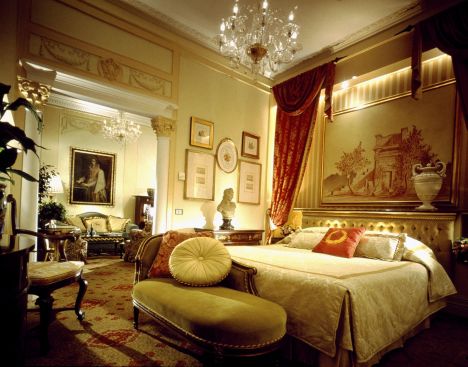
Junior Suite Bedroom. Every hotel room has its unique identity by means of a hand-painted fresco representing a roman ruin, monument of edifice above the headboard. Photo © St Regis Grand Hotel Rome.
The St. Regis Grand Hotel Rome by Starwood
In 1999, the Italian chef Umberto Vezzoli took over the hotel’s kitchens. More importantly, the same year, the CIGA hotel group was bought by Starwood. It was the end of an era.
The hotel closed for 10 months and reopened on December 16, 1999 as the St Regis Grand Hotel Rome. It had undergone a $35 million complete restoration and renovation. Some 450 craftsmen had given splendor back to the hotel, which was under the newly appointed direction of Stephen Alden, a young and ambitious general manager.
Incidentally, St Regis is the name of a legendary hotel in New York City, the Beaux Arts landmark built by Colonel John Jacob Astor IV at Firth Avenue and 55th Street in 1904. Colonel Astor died on the Titanic in 1912.
The hotel now offered 161 rooms including 23 suites. Plans for the new Bottega Veneta Suite were under way. A new restaurant, Vivendo, opened. I once had a small lunch there, which made a good impression. On my last stay, the restaurant had its annual closure. The current executive chef at Vivendo is Francesco Donatelli.
The St Regis Rome features traditional decorative styles of different ages, Empire being the dominant style. Superior rooms are decorated in red and gold color schemes with Murano chandeliers, damasks and plush velvets.
In 2008, the hotel’s gym was fresh and new. Most of the rooms are decorated in a traditional way. The hotel’s location is average because the Termini railway station area is not very stylish. Deluxe rooms feature Empire, Regency and Louis XV style furniture. Junior suites feature a combination of the same three styles as well as soft velvet armchairs, sofas and curtains in warm tones of red, gold and beige. The rooms appeal especially to an American clientele looking for a traditional hotel style. Butler service is complimentary with all suites.
More stylish are the movie presentations that took place at the St Regis Grand Hotel Rome since its reopening in 1999. Hannibal, The Talented Mr. Ripley, Vanilla Sky, Ocean’s Eleven, Minority Report and Gladiator are a few of the film’s presented here. For Chicago with Richard Gere, Catherine Zeta Jones and Renée Zellweger, a lavish party was organized in the lobby completely transformed into an 1920s Chicago ambiance.
Many Romans still refer to the St Regis as what it simply is and what you can read on top of the building: Le Grand Hotel.
The main source for this article – in addition to my stay at and information provided by the hotel – was the valuable book The Most Famous Hotels of the World: St. Regis Romeby Andreas Augustin (2008, 159 p.).

The historic façade of Le Grand Hotel. Photos © St Regis Grand Hotel Rome.
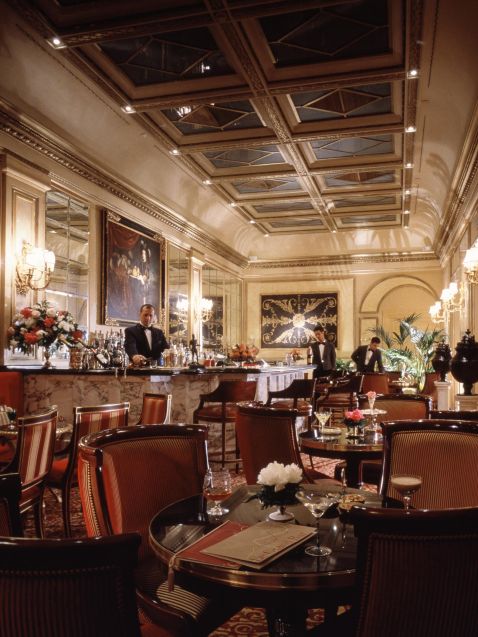
Le Grand Bar. Photos © St Regis Grand Hotel Rome.
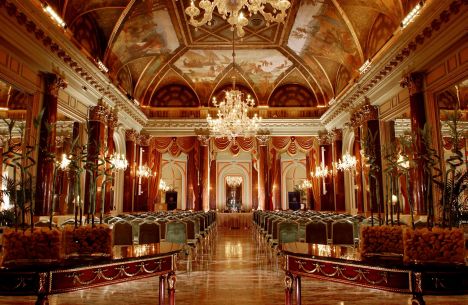
Ballroom. Photos © St Regis Grand Hotel Rome.
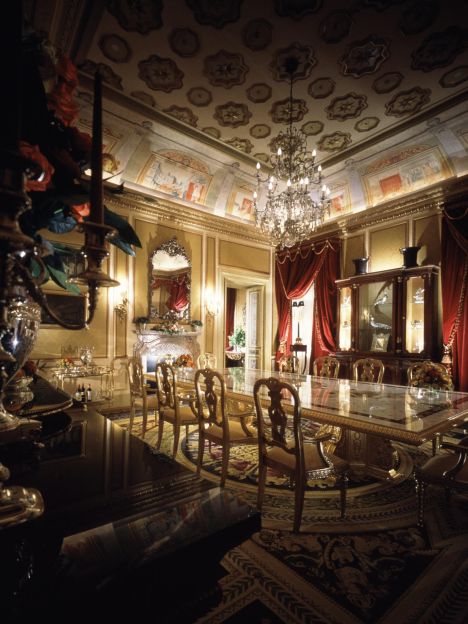
Royal Suite Dining Room. Photo © St Regis Grand Hotel Rome.

Designer Suite Living Room. The Bottega Veneta suite is a one-of-a-kind suite, Bottega Veneta considered the sensibility of both the hotel and the city. The result is a suite with a lighter palette and more open feel than the one in New York. Creative Director Tomas Maier. “We want to respect the character of the hotel, and acknowledge the light of Rome, through Bottega Veneta colors, materials and our furniture. So we’ve used very light colors like uniform khaki, palladio, linen, parchment, taupe and mustard-colors that feel cool and airy.” For the same reason, the floors are a natural-hued limestone – a smooth, cool treat for you bare feet, with limited areas covered in New Zealand wool carpets. The suite consists of a foyer, three bedrooms (two with separate sitting areas), three baths, and a living room with a fireplace and three large windows overlooking the city. Alcantara, leather, linen and all signature elements in Bottega Veneta interiors are used as upholstery, and window treatments. The rooms are furnished with pieces from the Bottega Veneta furniture collection, including elements from the new “camp” collection. There are also a few traditional pieces, such as an antique desk and classic armchairs reupholstered in linen or ultrasuede. Objects drawn from the home collection provide the finishing details – intrecciato linen pillows, hand-carved Venetian glassware, cashmere throws, and Bottega Veneta’s signature room fragrances. Photo © St Regis Grand Hotel Rome.
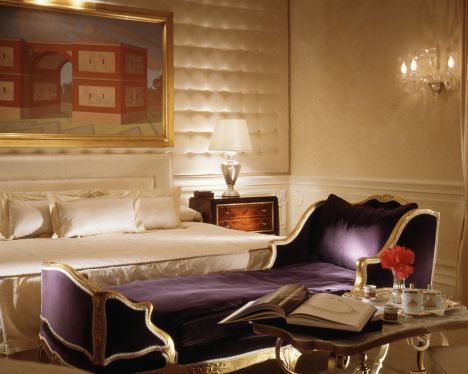
Designer Suite Bedroom. Photos © St Regis Grand Hotel Rome.
Art at the St Regis Grand Hotel Rome
Article by Heinrich Speich
Keeping a hotel on its high level always is a borderline experience between technology and good taste. At the last main renovation in 1999 the St.Regis has been fit out entirely with modern pictures – a fairly audacious step for a historic hotel with top expectations. The radicalism of the throughout conception with modern art doesn’t attract the admirer’s attention at the first glance. The paintings fit perfectly within the unique warm colours of the neo-baroque furniture. The management of the establishment looks back on more than one hundred years of hotel business on top level and is fully aware of the stylistic risks of such an enterprise.
In cooperation with the artists at the Galleria ed Associazione Il Politico under the direction of Arnaldo Romani Brizzi and Massimo Caggiano the paintings and sculptures have been arranged. Every piece of art has been designed and created especially for its position; none of it strikes out or offends the visitors’ eye, but fits easily in its place in the conception of the room. Well-known painters and critics contributed to the reinstallation in 1999. Starwood hotels invested about forty million dollars in renovations and new artistic orientation. The result isn’t half bad. The rooms and suites as well as the Vivendo and the Gran Bar reflect the successful combination of tradition and avant-garde of history and art.
The idea of fitting out the hotel with pieces of modern arts developed from the fact, that art is surrounding the visitor at Rome at every time. Why should the hotel be an art-free zone? On the contrary. The sculptor Alberto Mingotti and the artists Paolo Fiorentino, Mauro Reggio, and Anna Keen took charge to recompose classical Italian subjects and to keep present the spirit of the city inside the hotel. The hotel places itself in one row with the ancient princes’ and cardinals’ tradition of art patronage. Commissioned art and collection activity should give an aristocratic touch to the hotel, meeting point of Italian nobility ever since.
Two suites and several Rooms are entirely furnished by designers and turned into small museums of modern art. The Designer Suite 123 was initially created by Bvlgari, but now features other contemporary design. It represents the cool elegance of the eternal city. The suite number 231 “Colosseo” was designed by Anna Keen, 331 “Porta San Paolo” by Paolo Fiorentino and 431 “Pantheon” by Mauro Reggio. They reflect the warm climate and harmonize with the classic interiors of the rooms. The critic Alessandro Riva says that the artistic redecoration of a great historic hotel is “a highly symbolic enterprise.”
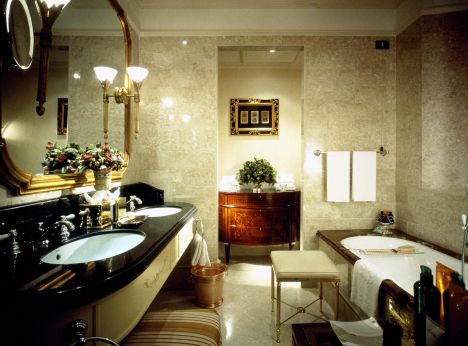
Junior Suite Bathroom. Photo © St Regis Grand Hotel Rome.
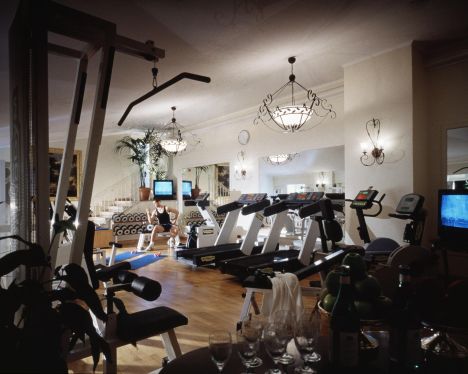
The gym and wellness center. Photos © St Regis Grand Hotel Rome.
Article by Louis Gerber added on October 1 and last updated on October 3, 2008